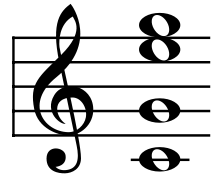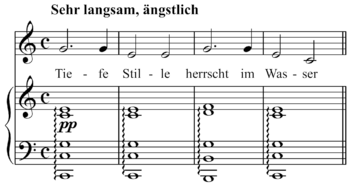Close and open harmony




Close harmony is an arrangement of the notes of chords within a narrow range, usually notes that are no more than an octave apart. It is different from open harmony or voicing in that it uses each part on the closest harmonizing note (such as C4–E4–G4), while the open voicing uses a broader pitch array (like C3–G3–E4) expanding the harmonic range past the octave. Close harmony or voicing can refer to both instrumental and vocal arrangements. It can follow the standard voice-leading rules of classical harmony, as in string quartets or Bach's Chorales, or proceed in parallel motion with the melody in 3rds or 6ths.
Impressionist composers like Claude Debussy and Maurice Ravel often used close harmony in their works and other intervals, such as 7ths, 9ths, and 11ths may be used, since the chords have 4 or more notes and the harmonies are more complex. In jazz, this influence is reflected in George Gershwin's work.
Vocal
Origins of this style of singing are found in harmonies of the 1800s in America. Early radio quartets continued this tradition. Female harmonists, like the Boswell Sisters (Mood Indigo,1933). The Hamilton Sisters and Fordyce (Who?You That's Who!, 1927), then became Three X Sisters. Both performed and recorded this style in the 1920s, and continued this onto commercial radio of the 1930s. Close harmony singing was especially popular in the 1940s with Pop and R&B groups using the technique quite frequently. The Andrews Sisters capitalized on a similar style too with Swing music. The Chordettes (Mr.Sandman, 1954), and the Supremes (Where Did Our Love Go?, 1964). Many gospel and soul groups in the 1950s and 60s also used this technique, usually 3- or 4-part SSAA or TTBB harmony with one person (either Bass or Lead) doing a call-and-response type lead. Examples of this are The Blind Boys of Alabama, a group that is still recording today. The folk-rock duo Simon & Garfunkel used close harmony, echoing their chosen role-models, The Everly Brothers.[3] The Louvin Brothers were a duo that used close harmony in the genre of country music.[4]
Barbershop harmony has a unique TTBB structure - the melody is in the 2nd tenor or "lead" voice, while the 1st tenor takes the next part up, usually in 3rds, with the baritone and bass voices supporting. The bass line tends to be more rhythmic and covers the root notes of the harmonic progression, providing more "support" and independence than in classical vocal music, since Barbershop is usually sung a cappella. Barbershop can be sung by males (TTBB) or females (SSAA). Public domain pieces, such as "Sweet Adeline", and newer pieces are abundant. National organizations promote the music with local chapters in many communities.
Soul and gospel groups flourished in America in the years after World War II, building on the foundation of blues, 1930s gospel songs and big band music. Originally called "race music" by white mainstream radio and its target market, it was the precursors to rock and roll and rhythm and blues of the 1950s, 1960s and 1970s, influencing many English and American artists of that era. As noted above, they often used the more traditional TTBB or SSAA 4-part structure, but with heavy use of solos and call-and-response, which is rooted in the African American church. These groups sometimes sang a cappella but also used more instrumental backing, especially when recorded by the bigger labels. Pop music and doo-wop can be seen as a commercialization of this genre.
Instrumental
A well-known example of consistent instrumental close harmony is Glenn Miller's "Moonlight Serenade" which uses the full range of single-reed wind instruments (soprano clarinet, alto, tenor, and baritone saxophones) to make a distinctive sound by harmonizing the different sections all within a single octave. Miller studied the Schillinger technique with Joseph Schillinger,[5] who is credited with helping Miller create the "Miller sound", and under whose tutelage he himself composed what became his signature theme, "Moonlight Serenade".[6]
Block harmony
In music, block harmony is close position harmonization, and contrasted with open harmony.
In organ performance block harmony means that close position chords are added below the melody in the right hand, and the left hand doubles the melody an octave lower, while in open harmony the middle note of the chord is played an octave lower creating a "open" space in the chord.[7]
See also
References
- ↑ Porter, Steven (1987). Harmonization of the Chorale, p.9. ISBN 0-935016-80-5.
- ↑ Jonas, Oswald (1982). Introduction to the Theory of Heinrich Schenker (1934: Das Wesen des musikalischen Kunstwerks: Eine Einführung in Die Lehre Heinrich Schenkers), p.18. Trans. John Rothgeb. ISBN 0-582-28227-6.
- ↑ Simon, Paul (April 20, 2011). "100 Greatest Artists: 33. The Everly Brothers". Rolling Stone. Retrieved 19 January 2014.
- ↑ Friskics-Warren, Bill (2011-01-26). "Charlie Louvin, Country Singer, Dies at 83". Retrieved 2017-02-15.
- ↑ "Joseph Schillinger, the forgotten Guru Archived May 4, 2006, at the Wayback Machine.", The Schillinger School of Music.
- ↑ "Who Is Joseph Schillinger?", The Schillinger System.
- ↑ Shanaphy, Edward and Knowlton, Joseph (1990). The Do It Yourself Handbook for Keyboard Playing, p.220. ISBN 0-943748-00-3.